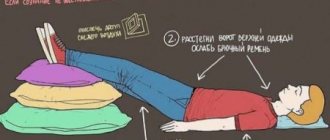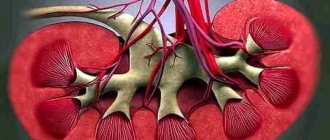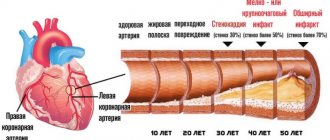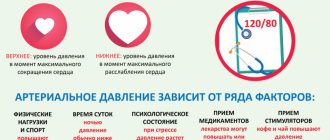Blood pressure is one of the main indicators of a person’s physiological state. A normal pressure is 120 to 80 mm Hg. Art., but it can be purely individual for each person.
Some people feel great with high blood pressure, while for others low blood pressure is normal.
Blood pressure is a variable value; its values can fluctuate depending on the influence of external and internal factors.
A moderate or sharp decrease in pressure is possible to 60 to 60 or 60 to 30 mmHg. Art., and what to do then will be prompted by a diagnostic examination and consultation with a cardiologist.
Blood pressure is especially unstable in older people, which in some cases poses a serious threat to human health and even life.
Pressure is 60 to 40, what to do, how to provide first aid, whether this is really a serious problem, and what the treatment is, we will consider further.
What do arterial values of 60 to 40 units indicate?
If the pressure drops to 60 over 40, what does this mean? In cardiology, a similar clinical picture is defined as arterial hypotension of a decompensated type, which is often accompanied by abnormalities in the autonomic system, which indicates low tone of blood vessels.
If you have hypertension, a person:
- Predisposed to motion sickness in vehicles.
- Suffering from chronic pain.
- It takes a long time to recover from physical stress.
- Cannot tolerate being in a stuffy and hot room.
Before diagnosing hypotension, your doctor will consider the following:
- If a low blood pressure level does not worsen the patient’s well-being, does not affect his performance and does not reduce vital activity, then such an arterial condition is not a pathology, but is considered just an individual characteristic of the body.
- The presence of severe symptoms and a significant deterioration in well-being are signs of the development of hypotension.
Depending on age
Medicine has determined the moments when a pressure of 60 over 40 is considered normal and when it is an anomaly.
During pregnancy
Given the individual tendency of a pregnant woman to have low blood pressure, 60/40 does not pose a clear threat to the expectant mother’s body, but there is a risk of fetal hypoxia due to slow blood flow.
With a pathological nature, blood pressure 60/40 manifests itself against the background of:
- Early toxicosis.
- Additional uteroplacental blood circulation (the placenta produces hormones that negatively affect the pituitary gland).
- High levels of progesterone.
- Iron deficiency anemia.
- Carrying twins.
- Improper outflow of venous blood.
- Vegetative-vascular dystonia.
- Unbalanced diet.
- Vena cava syndrome.
- Emotional stress.
What to do?
A drop in blood pressure in a patient against the background of severe emotional shock (or due to the influence of environmental factors) indicates the need to consult a specialist. What should you do if your blood pressure drops to 70/40 and continues to drop?
Treatment for hypotension usually consists of various homeopathic, herbal preparations, the main task of which is to stimulate the body. There are also many caffeine-based medications for low blood pressure.
Doctors often recommend drinking a cup of freshly brewed coffee in the morning to enhance the body's metabolic processes. True, its excessive use can provoke the development of pathological symptoms - tachycardia, severely increased blood pressure.
When prescribing the drug to a patient with hypotension, doctors advise adherence to a healthy lifestyle. At low blood pressure, minimal physical activity is indicated.
This could be walking, light exercise on the gym. You should pay attention and make adjustments to your daily diet. It is necessary to carefully monitor the amount of salt and spices in food, and reconsider the value of products and their quality.
To quickly raise low blood pressure at home, it is best to use tinctures or medications. Everyone should have medications that can quickly raise blood pressure in their first aid kit.
Medicinal tinctures are indicated for hypotension (tincture of eleutherococcus, lemongrass or ginseng). The following medications can be purchased without a prescription: caffeine sodium benzonate, or others containing caffeine.
All of them can only help with irregular pressure surges, eliminating negative symptoms.
If the pressure drops 70 to 40, what should you do? Symptomatic help will help restore blood pressure and cope with unpleasant symptoms.
Effective treatments for hypotension
There are many methods to raise blood pressure at home. They are effective only for people whose blood pressure does not decrease on an ongoing basis and is not chronic and associated with illness. Let's list some:
- To raise your blood pressure, you can drink sweet, strong coffee (if low blood pressure is an isolated case).
- Use tinctures of ginseng or eleutherococcus; lemongrass infusion is also suitable.
- Massage of the back of the head, temples.
- Physical activity - walking or light exercise, which will increase blood pressure.
- Any alcoholic drinks (they also raise blood pressure).
- Drugs for raising blood pressure “Dobutamine”, “Camphor”, “Strophanin”, “Mezaton”, “Caffeine sodium benzoate” are taken under the supervision of a doctor.
If you notice that your blood pressure changes every day, and this difference is more than 30-40 mm Hg. for no apparent reason, you should consult a general practitioner or cardiologist.
Prevention
The main way to prevent hypotension and all its consequences is to influence factors that can be easily corrected.
You should increase the volume of liquid you drink to 2-2.5 liters per day, add more salt (kitchen salt) and salty foods to your diet. It is necessary to exclude the use of alcoholic beverages and tobacco products. It would be useful to evenly distribute the load between mental and physical labor.
This applies to a greater extent to patients under 16 years of age. At this age, there is an active restructuring of organs and systems, and the heart does not have time to increase the volume of blood transferred in accordance with the pace at which the young body grows and develops.
You need to follow an individual sleep schedule, allocating at least 7 hours to it. It is worth using high, moderately hard pillows. Minimize time spent in cramped, hot spaces and avoid standing for long periods of time or overheating.
If hypotension manifests itself as a pre-fainting or fainting state, you need to learn to sense and differentiate the precursors of these manifestations. Try to raise your pulse and blood pressure by any means (for example, a glass of cold water or light physical activity).
What situations are characterized by low blood pressure?
Why does blood pressure rapidly drop to 60 to 40 units? A decrease in pressure to 60/40 can occur for the following reasons:
- Sedentary lifestyle.
- Drinking alcoholic beverages.
- Nicotine addiction.
- Systematic stress.
- Diseases of the cardiovascular system.
- Wrong diet.
- Pathologies of the adrenal glands and respiratory organs.
- Physical stress.
- Diseases of the central nervous system.
- Severe stage cancer.
- Overheating in the sun.
- Anaphylactic shock.
- Gastrointestinal bleeding.
- Cardiogenic shock.
- Chronic diseases of the endocrine system.
- Work involving high temperatures.
The following are prone to hypotension:
- People of asthenic type (pale skin, blond hair, thinness, sickly appearance).
- Teenagers (puberty).
- Pregnant women.
- Professional athletes.
- Patients with a hereditary predisposition to low blood pressure.
Asthenics lead an active life, are not distinguished by endurance and physical performance, while chronically low blood pressure does not cause them any discomfort. Such people do not feel well when their blood pressure is 120 to 80 or higher.
Doctors identify several factors that most often cause blood pressure to drop abnormally low:
Cardiogenic shock
If the pressure drops to 60 to 40, then this may be a sign of the sudden development of the first stage of cardiogenic shock (oxygen deficiency). In most situations, it is precisely when there is poor oxygen supply to the brain tissue that a sudden decrease in blood pressure occurs to extremely dangerous values.
When this painful condition manifests itself, the following is noted:
- Decreased cardiac output.
- Loss of the heart's ability to pump blood out correctly.
Cardiogenic shock has 4 types of manifestations:
Cardiogenic shock, a sign of excessively low blood levels, is a consequence of:
- A heart attack when 40% of the heart muscle is affected.
- Damage to the interventricular septum.
- Heart valve insufficiency.
- Presence of myocarditis.
- Arrhythmias of various origins.
- Manifestations of pulmonary artery embolism.
Patients who have a history of:
- Previous heart attack.
- Diabetes.
- Contact with cardiotoxic substances.
Symptoms of the disease and its danger
The consequences of low blood pressure are quite unpleasant. They are mainly associated with cerebrovascular accidents. The patient feels unwell, throbbing pain appears in the temporal region, as well as migraine pain. Dizziness, nausea, and vomiting may occur. There are many other signs that blood pressure is low:
- fatigue, weakness, decreased performance;
- when suddenly rising from bed or chair, the vision becomes dark and dizziness occurs;
- possible development of fainting;
- absent-mindedness, memory impairment;
- mood swings, tendency to depression;
- drowsiness;
- chest pain, rapid heartbeat;
- violation of thermoregulation;
- increased sweating of the feet and palms.
In addition, hypotension is accompanied by disturbances in the functioning of the digestive system. In women, the menstrual cycle may be disrupted, and in men there is a decrease in potency.
Is blood pressure 70/40 dangerous?
If hypotension is physiological and moderate, the patient tolerates this condition normally, then the disease does not pose a direct danger. However, with a pressure of 70 to 40, which has been observed for a long period or has dropped sharply, various pathologies can develop. To avoid any complications, you should consult a doctor to determine the cause of low blood pressure.
In most cases, hypotension is virtually asymptomatic. But if autonomic reactions develop (headaches, ringing in the ears, dizziness), this can lead to visual impairment, coordination, and fainting. Gradually, the body becomes weaker, physical endurance decreases, and interruptions in the functioning of the heart muscle and brain appear.
A pressure of 60 over 40 is considered critical. This condition is very dangerous not only for health, but also for human life. The heart does not work properly, and the functioning of all body systems, including the brain, is disrupted. Such numbers indicate the beginning of the development of cardiogenic shock.
Also, in severe cases, arterial hypotension can lead to the development of other quite dangerous conditions:
- acute myocardial infarction;
- hypothyroidism;
- decreased adrenal function;
- anaphylactic shock;
- gastrointestinal bleeding.
Manifestation of clinical symptoms
Blood pressure 60/40, provoked by pathological processes, is characterized by bright specific symptoms, similar to those that a person feels during a heart attack or poisoning.
If the blood level drops, the patient complains of the following:
- Deterioration in the overall health of the body.
- Marked weakness.
- Extreme fatigue.
- Increased irritability.
- Persistent drowsiness.
- Constant headache.
- Hypersensitivity to bright lights and loud noise.
- Flashing dots before the eyes.
- Darkening of the eyes when bending over quickly.
- Increased heart rate during physical activity.
- Shortness of breath during activity.
- Decreased sexual desire.
- Weak muscle tissue tone.
- Significant decrease in body temperature.
- Cold extremities.
- Hypersensitivity of the body to cold and heat.
With severe hypotension, the blood supply to the brain tissue is disrupted, which is manifested by additional symptoms:
- Memory loss.
- Marked absent-mindedness.
- Severe migraine.
- Systematic dizziness.
- Gastrointestinal disorder.
- Decreased ability to concentrate.
Regarding cardiogenic shock, its specific signs develop rapidly:
- Instant decrease in body temperature.
- Pallor of the facial skin.
- Blue lips.
- Nausea.
- The surface of the skin becomes moist and acquires “marbling”.
- Feeling of heartbeat.
- Manifestation of pain in the chest area.
- Shortness of breath and severe weakness.
- Numbness of the limbs.
- Rare pulse, but with a further gradual increase in its rhythm.
- Feelings of anxiety and fear of death.
- Poor kidney function.
- Reduction or complete absence of urine discharge.
- Loss of consciousness.
How does very low blood pressure manifest itself?
Naturally, a person with such pressure will have poor general health, severe weakness, obsessive headaches and dizziness. He will be lethargic, tired, completely exhausted. His skin will be pale and there will be blue (dark) circles under his eyes. He will most likely feel sick. The person is drowsy, apathetic, and even little things irritate him.
He feels a strong heartbeat and shortness of breath, which only intensifies with the slightest physical exertion. A person, as a rule, has unusual muscle weakness; it is extremely difficult for him to simply stand for a few seconds. He has a low body temperature, chills, and his limbs are cold.
The patient feels problems in perceiving reality; first of all, logic and memory suffer; he cannot concentrate on anything. The digestive organs also suffer - various dyspeptic manifestations occur.
What are the consequences of low blood pressure?
A decrease in pressure to 60/40 is dangerous due to the following consequences:
- Hypotonic attack.
- Decreased visual acuity.
- Stroke.
- Bleeding of the uterus and miscarriage in pregnant women.
In addition, the development of cardiogenic shock can lead to irreversible complications:
- Stopping the functioning of all internal organs due to poor blood circulation in the brain area. In this case, the functionality of brain cells and kidneys is suspended.
- The onset of death.
Emergency assistance before the ambulance arrives
What to do if the pressure drops to 60/40 and is accompanied by serious symptoms? In this situation, call an ambulance immediately, and before it arrives, do the following:
- Lay the patient down so that the legs are higher than the head level.
- Perform a massage in the area of the carotid artery.
- Apply a warm (hot) compress to your forehead.
- If severe pain occurs, give an analgesic tablet.
- You can increase your blood pressure with strong tea or coffee.
- It is allowed to take ginseng extract.
- Ensure complete rest.
- Open the window for additional fresh air.
- If an oxygen bag is available, use it for its intended purpose.
What to do with such indicators?
If a drop in blood pressure occurs due to stress, overload of the body, as well as under the influence of other external factors, then emergency assistance is needed, which can be provided at home.
First aid usually includes herbal medications that have a stimulating effect on the body, as well as drugs whose active ingredient is caffeine.
Excessive doses of caffeine should be avoided, as high concentrations can lead to vasodilation and worsening of the condition.
Increased blood pressure can be achieved:
- drinking black strong sweet tea or coffee;
- ventilation of the room;
- raising the patient's legs;
- freeing the chest from constricting clothing;
- deep and measured breathing;
- taking a contrast shower;
- eating sweets;
- tincture of ginseng or lemongrass.
Medicines that can be used:
- preparations with caffeine - for example, sodium caffeine benzoate;
- psychostimulant medications;
- herbal medicines - for example, Eleutherococcus extract);
- vitamin and mineral complexes.
To prevent hypotension, it is recommended:
- increase physical activity;
- spend more time in the fresh air;
- drink more fluids;
- avoid stress;
- carry out timely treatment of existing diseases.
If hypotension is caused by pathology of internal organs, then to prevent an unfavorable outcome, consult your doctor as soon as possible.
Ways to restore pressure at 60 to 40
A blood pressure of 60 over 40 is a serious reason for immediate hospitalization. Treatment should be carried out under the supervision of a doctor.
Intensive care in hospital settings
Upon arrival at the hospital, the patient is given:
- Urgent electrocardiogram.
- Echocardiogram (the ability of the heart muscles to contract is assessed).
- Angiography (vessels are examined for any abnormalities).
The presence of cardiogenic shock requires intensive therapy, the main goal of which is to:
- Stabilization of blood pressure to normal levels.
- Improved blood circulation.
- Supplying internal organs with stable blood flow.
Oxygen therapy is used in this direction. Painful manifestations are relieved with analgesics. To normalize the patient’s well-being, special drugs are administered intravenously, the effect of which is aimed at the following:
- Improvement of renal blood flow.
- Raising blood pressure to normal.
- Increased contractile function of the heart.
- Expansion of the lumen of the renal arteries.
- Elimination of nutritional deficiencies in cardiac tissues.
To maintain the myocardium, medications are prescribed:
Surgery
Surgical treatment is prescribed when the results of intensive therapy are ineffective.
During the operation, the patency of arterial vessels is restored by pumping blood fluid into the aorta.
Medical nutrition
According to doctors, a deficiency of certain vitamins in the body contributes to a strong decrease in blood pressure, in particular:
- Vitamin E
- Vitamin C.
- B vitamins.
To prevent subsequent manifestations of arterial hypotension, the menu should include:
If a person’s blood pressure is recorded at 60 over 40, this means that he requires emergency medical care. Therefore, if a patient experiences weakness, chills, pale skin and fainting, do not hesitate to call an ambulance. Slowing down in such a situation threatens with irreparable consequences.
Symptoms of the condition
With low blood pressure, specific symptoms appear that are difficult to miss. Among the main symptoms are the following:
- deterioration of general condition;
- feeling of weakness;
- pain in the head area;
- drowsy and lethargic state;
- darkening in the eyes (especially when moving the body) and the appearance of goosebumps in front of them;
- during exercise, the heart beats excessively and shortness of breath is noted;
- the person experiences irritability;
- increased sensitivity to light and sounds appears;
- decrease in temperature indicators;
- feeling of chills in the extremities;
- weak muscle condition;
- decreased libido.
Chronic low blood pressure is characterized by symptoms that indicate poor blood supply to the brain, namely:
- memory deteriorates;
- inattention at work appears;
- frequent migraines and dizziness are noted;
- a disorder in the functioning of the gastrointestinal tract is recorded.
Return to contents
Is there any reason to worry?
As a rule, a moderate decrease in blood pressure does not have much impact on the quality of life. This condition refers to the characteristics of the body and can be corrected. In addition, hypotension has its positive aspects. For example, people with low blood pressure are not contraindicated to drink a cup of strong coffee in the morning, which cannot be said about people with high blood pressure. In addition, doctors believe that the development of atherosclerosis slows down in hypotensive patients.
There are cases when a patient’s low blood pressure increases and returns to normal. You should not worry if a person’s blood pressure is low and there is no deterioration in health. But if your general condition is disturbed and unpleasant symptoms appear, you should not postpone a visit to the doctor, who will conduct a thorough examination. You should not hesitate in such a situation, the consequences may be irreparable.
Consequences of a significant decline
The above applies to cases of a slight decrease in pressure from the norm. If the pressure drops significantly, for example, 60 over 40 or 60 over 30, the patient requires immediate help. Low values of upper and lower pressure indicate cardiogenic shock - a condition in which the heart muscle stops expelling blood with the necessary force. During this condition, disruption occurs in all systems and organs of the human body due to a sharp lack of blood supply. First of all, the functioning of the kidneys and brain is disrupted. Often, oxygen starvation of the brain often causes the death of the patient.
A blood pressure reading of 60 to 40 indicates the 1st degree of cardiogenic shock. The symptoms of this pathological condition develop rapidly. The patient's skin becomes cold and pale, lips turn blue, and the skin becomes marbled. The patient has a beating heart, pain in the chest, weak pulsation with a noticeable increase in frequency and fainting. Against the background of such symptoms, a person is restless and afraid of death. Cardiogenic shock is classified into types, which are described in the table.
A pressure of 60 to 40 can be caused by severe physical or psycho-emotional exhaustion, as well as certain diseases. In this case, the patient experiences weakness, dizziness, indigestion and pale skin. The most dangerous is oxygen starvation of the brain, followed by the possible development of coma and death.
Most often, a drop in blood pressure to such figures is due to cardiogenic shock.
Low blood pressure: when to sound the alarm
Many people live with low blood pressure for years and don't even notice it. On the contrary, if it increases slightly, they feel bad. Hypotonics have their advantages, for example, they drink coffee in the morning not only for pleasure, but also to increase blood pressure, while hypertensives are strictly prohibited from this aromatic drink.
People with low blood pressure, according to doctors, are less likely to develop atherosclerosis.
Interesting! Those who have lived with low blood pressure all their lives often experience normalization with age.
But if the readings have always been normal and drop sharply, while the condition worsens and all the symptoms of hypotension appear, you should immediately consult a doctor. Do not hesitate, because almost all organs suffer from this. The doctor may prescribe additional examination to rule out the development of any disease.
Causes and symptoms
If a person has a blood pressure of 60/40, then this is the result of the following factors affecting the body:
- exhaustion of the body;
- physical fatigue;
- excessive activity of the vagus nerve;
- arrhythmia;
- disruption of the heart;
- infectious-toxic shock;
- significant blood loss;
- dysregulation of the autonomic nervous system;
- dehydration;
- playing sports;
- psycho-emotional stress.
Low blood pressure causes a person to develop the following clinical symptoms:
If a person’s blood pressure decreases, then his limbs begin to freeze.
- poor general health;
- constant weakness;
- dizziness;
- headache;
- lethargy;
- nausea;
- pale skin;
- drowsiness;
- dark circles before the eyes;
- palpitations and shortness of breath, which worsens with physical activity;
- irritability;
- low body temperature;
- muscle weakness;
- decreased libido;
- chills;
- cold extremities;
- memory and attention impairment;
- decreased performance;
- inability to concentrate;
- digestive system disorder.
Return to contents
Consequences
Dangerous complications for a patient suffering from arterial hypotension include oxygen starvation of the organs and tissues of the body, which completely disrupts its functioning. In this case, damage is mainly observed in neurons of the brain. In severe cases, a drop in blood pressure to 60/40 or 50/30 can cause coma and death. If the patient is in a standing position, then a sharp drop in pressure causes orthostatic collapse with loss of consciousness. Patients also suffer from obsessive states, panic attacks and fear of death.
Consequences
When pressure readings drop to critical values: systolic to 60 and diastolic to 40, this may be a symptom of another disease, for example, bleeding in the gastrointestinal tract, heart attack, or dysfunction of the adrenal glands.
When the heart cannot cope with its function and does not push blood with the required force, this negatively affects the functioning of all organs and systems of the body. The brain and kidneys begin to suffer first. If you do not contact a doctor in time, this can cause irreversible processes in the body, even death.
Cardiogenic shock is manifested by the following symptoms:
- Unnatural paleness of the skin, they become cold.
- Manifestation of a marbled pattern on the skin, cyanosis of the lips.
- The heartbeat quickens, shortness of breath and weakness appear.
- Fear of death and excessive anxiety appear.
- Most people lose consciousness.
Cardiogenic shock has a fairly high mortality rate. Therefore, you should immediately call an ambulance.
First aid
If there is a sharp drop in blood pressure, the person is provided with rest and a horizontal position. The patient's legs should be higher than his head. This will prevent loss of consciousness in a bedridden patient and greater blood circulation to the head and oxygen supply to the brain. This procedure will help prevent neuronal ischemia and subsequent cognitive impairment. It is important to ensure a flow of fresh air, so open the windows and ventilate the room. Whenever possible, an oxygen cushion should be used. It is advisable not to make sudden movements of the patient and protect him from stress. It is important to eliminate the reasons causing the decrease in blood pressure. Before the ambulance arrives, ensure the patient drinks warm sweet tea or water.
What to do for treatment?
When the pressure drops to 60 to 40, the patient needs to take urgent measures aimed at eliminating oxygen starvation of the cerebral cortex. For this purpose, patients are administered Dopamine, Bellatamine or Epinephrine. They are also prescribed a long-term course of herbal remedies - caffeine, Eleutherococcus extract, ginseng tincture and other means that promote vasoconstriction and increase blood pressure.
It is also important to ensure the flow of sufficient fluid to the bloodstream. To do this, drip hypertonic solutions are used to replenish the deficiency and retain fluid in the body. To normalize the functioning of the autonomic nervous system, the use of tranquilizers, antidepressants and sedatives of plant origin is indicated.
Constant low blood pressure often means an increase in the tone of the vagus nerve, which is a hereditary pathology.
Causes
Scientific research has led to the emergence of several independent theories about the sources of the disease. These include:
Constitutional-endocrine - hypotension is formed against the background of a primary decrease in vascular tone as a consequence of dysfunction of the adrenal cortex. Upon careful study, it was found that with pathology, certain functions of the adrenal glands decrease: mineralocorticoid, glucocorticoid and androgenic type.
Vegetative – the cause of the disease is considered to be an increase in the functioning of the cholinergic and a decrease in the functionality of the adrenergic department. Clinical indicators indicate an increased amount of acetylcholine, a decrease in the amount of catecholamine in the bloodstream and urine. Insufficient production of norepinephrine provokes a decrease in diastolic and average blood pressure levels.
Deviations in the functioning of the sympathetic-adrenal department predispose to instability in the circulatory department and blood circulation in the brain, disruption of the respiratory system, and a decrease in oxygen consumption.
Neurogenic - this theory is recognized by almost all specialists. Deviations in blood pressure regulation of the neurogenic pathway are the main sources of the disease. Changes in processes are influenced by psychogenic factors, and a unique type of neurosis is observed. The problem provokes hemodynamic abnormalities: capillary dysfunction with a decrease in peripheral resistance.
Specific causes of the development of the disease cannot be detected, but there is a version of the relationship between low blood pressure and genetic factors and disorders of physiological regular mechanisms. Hypotension provokes autoregulation processes, a discrepancy between minute blood volume and peripheral vascular resistance. As the disease develops, the latter gradually decreases.
Humoral - the problem is caused by an increase in kinins, prostaglandin A, E, which have a vasodepressor effect. Great importance is attached to the amount of serotonin and its derivatives in the bloodstream, which are responsible for normalizing blood pressure.
The primary type of pathology is attributed to individual variations of neurosis of the vasomotor center with deviations in the functioning of the peripheral depressor system and a secondary change in the functionality of the adrenal glands. This type of illness is provoked by diseases of the kidney, endocrine, gastrointestinal, cardiovascular, central nervous system, and taking certain medications.
A sudden drop in pressure of 70 to 40 can be provoked by massive bleeding, long-term unbalanced diet, allergic reactions, dehydration, pregnancy, sudden climate change, and stressful situations.
Prevention measures
It is possible to prevent dangerous consequences for the human body when blood pressure is 60 over 30 if you adhere to proper nutrition with sufficient fluid and salt intake. It is also important not to overwork, avoid psycho-emotional stress and heavy physical labor. You need to get enough sleep; taking multivitamin complexes and a contrast shower will be helpful, which will help maintain the tone of the vascular wall.
Each person's blood pressure level is different. Some people tend to be high, while others, on the contrary, are usually low. What pressure is considered normal and what is considered low? When should you see a doctor? You will learn all this from our article.
Etiology
Hypotension constantly accompanies people who have an asthenic physique, tall and thin, as well as those who have pale skin. These are mainly teenage children and women. Hypotension is common in pregnant women. This group of people suffer from intolerance to being in stuffy and crowded rooms, have constant weakness, frequent dizziness and headaches, quickly get motion sickness in transport and take a long time to recover from physical activity. Many hypotensive people are found among people involved in professional sports.
Reduced blood pressure and pulse act as a protective reaction of the body to heavy physical activity.
Meaning of indicators
The medical community clearly outlines the boundaries of normal pressure for the adult population from 100/60 mm Hg. Art. up to 139/89 mm Hg.
In children, each age has its own blood pressure indicators.
Low blood pressure is often recorded in bedridden patients. Elderly people and pregnant women are prone to hypotension, which is associated with low adaptive capabilities.
In most cases, treatment for low blood pressure is not required, but if it interferes with the normal rhythm of life, you should consult a doctor. The most common manifestations of hypotension include:
- dizziness;
- weakness;
- drowsiness;
- sleep disorder;
- pale skin;
- cardiopalmus;
- low performance.
Complete a clinical minimum of examinations, which will allow you to exclude organic causes of arterial hypotension.
How to raise low blood pressure 60/40? You can drink a cup of natural coffee, 20 drops of lemongrass or ginseng tincture, and also take 1 tablet of citramon.
If your blood pressure drops to 60 to 40 mm Hg. the above methods will not help, since cardiogenic shock is already developing.
Why does blood pressure drop so much?
For some people, low blood pressure (hypotension) is a congenital feature, and they do not feel any discomfort. For others, a slight decrease in blood pressure is accompanied by unpleasant symptoms and is accompanied by a loss of strength.
A short-term decrease in pressure may occur for the following reasons:
- weather and climatic conditions;
- some medications;
- stimulants and alcoholic drinks;
- stressful situations;
- excessive physical activity;
- mental stress;
- poor diet or starvation.
Also, the reasons for such a decrease in blood pressure may be:
- sudden standing up from a “lying” or “sitting” position;
- visiting baths and saunas, where elevated temperatures lead to vasodilation (therefore, older people need to exercise moderation and caution);
- a sedentary lifestyle, leading to a decrease in muscle volume and deterioration of pulmonary ventilation.
Sometimes, in order to normalize blood pressure, you should rest well, get enough sleep, and then avoid stressful situations.
To a persistent decrease in blood pressure to 60 to 40 mmHg. Art. Pathological reasons may include:
- diabetes;
- severe blood loss;
- cervical osteochondrosis;
- pathological abnormalities in the functioning of the central nervous system;
- vegetative-vascular dystonia of hypotonic type;
- dysfunction of the thyroid gland;
- traumatic brain injuries;
- infectious lesions;
- cardiovascular diseases;
- disruption of the circulatory system
Cardiogenic shock
This acute condition, requiring emergency treatment, is characterized by a sharp drop in blood pressure to 60/40 mm Hg, decreased blood supply to vital organs, and increased vascular resistance.
Cardiogenic shock is caused by:
- myocardial infarction affecting a large area of the left ventricle;
- myocarditis;
- rupture of the interventricular septum;
- severe arrhythmias;
- pulmonary embolism;
- poisoning with cardiotoxic poisons.
For any of the above reasons, the clinical picture of shock will be approximately the same: low blood pressure, rapid pulse, pain in the heart, darkening of the eyes, high vascular tone, oliguria, lethargy, fear of death.
The development of cardiogenic shock is possible at any age, but it often occurs in middle-aged men, which is associated with undiagnosed arterial hypertension.
According to the degrees of hypotension there are:
I degree - blood pressure 90/50-60-40 mm Hg. The patient's consciousness is preserved, acute heart failure is mild.
II degree - pressure 60/40-40/20 mmHg. Symptoms of acute heart failure, oliguria, and increased vascular resistance come to the fore.
III degree - severe collapse, blood pressure levels are often not determined, symptoms of acute heart failure increase, and pulmonary edema occurs.
Causes of pressure 70 to 40
Blood pressure readings are below 10060 mmHg. Art. are defined as a hypotonic state if they are recorded for a long time. A periodic decrease in this indicator may be due to physiological factors:
- orthostatic collapse (with a sudden change in body position);
- prolonged hypothermia;
- emotional and physical fatigue;
- stress;
- eating (postprandial hypotension);
- climate change, reaction to weather changes;
- pregnancy.
In addition, low blood pressure is common among professional athletes. A decrease in blood pressure and heart rate in physically trained people is a compensatory reaction as a result of constant stress (the body conserves strength).
Blood pressure indicators depend on cardiac output (the volume of blood that is ejected by the left ventricle into the aorta), heart rate, and peripheral vascular resistance, which ensures the delivery of blood through the smallest capillaries. In diseases of the cardiovascular system, these parameters change, which helps to lower blood pressure. Such pathologies include:
- arrhythmias accompanied by a decrease in heart rate;
- cardiosclerosis;
- myocardial infarction;
- pulmonary embolism;
- neurocirculatory dystonia of the hypotonic type;
- atherosclerosis;
- heart failure.
In addition to “heart” diseases, lower blood pressure is caused by diseases of organs and systems that directly or indirectly affect the functioning of the heart, the volume of intravascular fluid, and the regulation of arterial tone. These include:
- damage to regulatory centers in the medulla oblongata due to traumatic brain injury;
- pathological loss of fluid (dehydration) with excessive vomiting, diarrhea, overheating;
- acute poisoning of the body;
- asthenia, as a manifestation of many diseases;
- massive bleeding;
- shock of any etiology;
- hypothyroidism
Hypotension can manifest itself as an undesirable effect when taking certain medications (against hypertension, coronary artery disease, diuretic local anesthetics, antidepressants, etc.). Reduced blood pressure is observed in patients who have undergone long and difficult operations and are on constant bed rest.
First aid
What to do if cardiogenic shock develops?
- Call an ambulance.
- Place the patient in a supine position, raising his legs 15 degrees above his head.
- Unbutton the collar of the patient's shirt for better air access.
- If necessary, give pain medication.
- Cardiopulmonary resuscitation may be required until the ambulance arrives.
50% of success in further treatment depends on competently provided care at the prehospital stage.
Therapy for cardiogenic shock begins directly in the ambulance, during transportation to the intensive care unit. The treatment plan includes:
- effective pain relief;
- oxygen therapy;
- thrombolytic therapy;
- infusion therapy;
- administration of vasopressors;
- intra-aortic balloon counterpulsation;
- surgical treatment for myocardial ruptures.
Cardiogenic shock is very dangerous, the mortality rate reaches 75-100%, so you cannot refuse hospitalization, tablets and injections, or try to cope with it yourself!
Preventive measures
To prevent cardiogenic shock, it is necessary to prevent the development of myocardial infarction and severe arrhythmias, as its most common causes. To do this, strictly adhere to the treatment plan prescribed to you. Make lifestyle adjustments. Increase your physical activity, give up cigarettes and alcoholic beverages, include lean meats and fish in your diet 2 times a week, and reduce body weight.
These simple steps will help you reduce your risk of heart attack and prolong your life.











